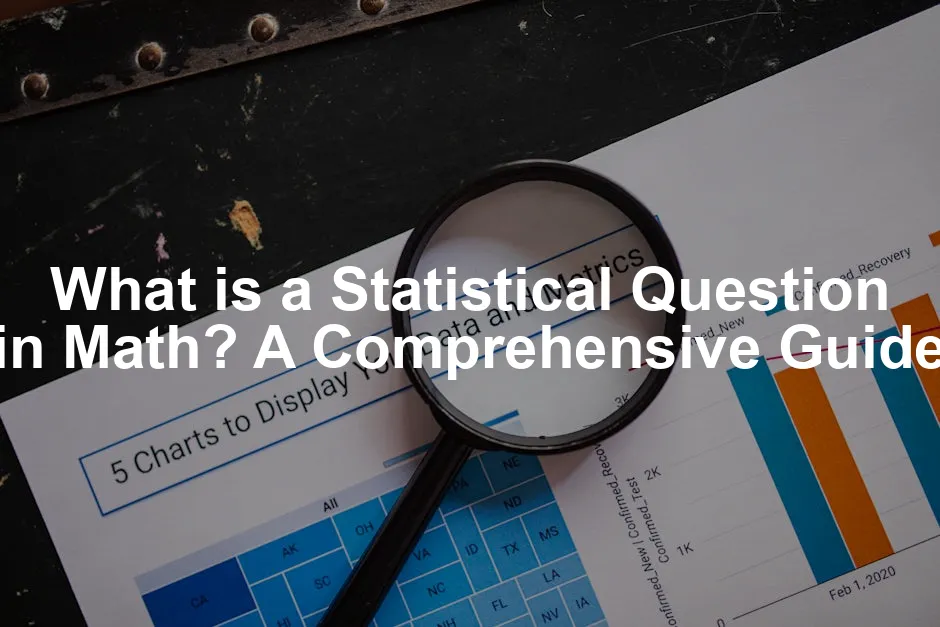Introduction
Understanding statistical questions is crucial in mathematics. These questions guide us in collecting and analyzing data. Statistics help us make sense of the world by revealing patterns and trends. Without statistical questions, we’d be lost in a sea of numbers.
Statistical questions are everywhere—in education, healthcare, and business. For example, in education, teachers assess student performance using statistical questions. In healthcare, doctors track patient outcomes. Businesses analyze market trends to make informed decisions. Each field relies on statistical questions to gain insights.
In this article, you’ll learn the definition of statistical questions. We’ll explore key characteristics that differentiate them from non-statistical questions. You’ll also discover how to identify statistical questions in everyday life. By the end of this guide, you’ll be equipped to tackle statistical inquiries with confidence and flair.
For those wanting to dive deeper into the world of statistics, consider picking up Statistical Analysis with Excel For Dummies. This book is perfect for anyone looking to navigate statistics using one of the most popular tools available!

Understanding Statistical Questions
Definition of a Statistical Question
A statistical question is one that anticipates variability in its answers. It’s not a simple yes or no question. Instead, it expects a range of responses. For example, “How many hours do students study each week?” This question requires collecting data from various students, leading to different answers.
Statistical questions are essential for gathering meaningful data. They prompt researchers to analyze information rather than just providing a single fact. This variability in answers reflects real-world complexities. It allows us to draw conclusions and make predictions based on diverse data sets.
Moreover, statistical questions often lead to deeper exploration of the data. They can reveal trends, averages, and patterns that inform decisions. By understanding what makes a question statistical, we can better appreciate the role of statistics in our lives.
If you’re keen on understanding data better, grab a copy of The Art of Statistics: Learning from Data. This book will not only enhance your understanding but also make you the go-to statistician among your friends!

Key Characteristics of Statistical Questions
Statistical questions are not just any queries; they come with specific traits. Understanding these characteristics will help you identify them in everyday scenarios.
Variability
Variability is the heartbeat of statistical questions. It indicates that answers will differ. For instance, if you ask, “What is the average height of students in a class?” you expect varied heights. This variation is delightful! It means that each student contributes a unique perspective. Without variability, we’d be stuck with boring, one-size-fits-all answers. Imagine if everyone was the same height—how dull would that be? Recognizing variability is crucial because it sets the stage for gathering meaningful data. After all, life is all about differences and diversity!
To gain a deeper understanding of variability, consider reading Naked Statistics: Stripping the Dread from the Data. This book makes statistics approachable and enjoyable!

Data Collection
To answer statistical questions, data collection is essential. You can’t just throw a question out there and hope for the best. For example, if you want to know, “What percentage of students prefer chocolate ice cream?” you need to survey a group. Collecting data helps you avoid guesswork. It transforms opinions into facts. Data collection can involve surveys, experiments, or observations. Each method brings its flavor to the table, making your findings more robust and reliable. Think of data as the ingredients needed to whip up a delicious statistical dish!
For those serious about mastering data collection techniques, check out The Data Warehouse Toolkit: The Definitive Guide to Dimensional Modeling. This guide is a must-have for anyone looking to excel in data management!

Analysis Potential
Statistical questions pave the way for in-depth analysis. Once you collect data, the fun really begins! You can calculate averages, determine trends, and even predict future outcomes. For example, after finding out how many students prefer chocolate ice cream, you can analyze if preferences change by season or age. This potential for exploration allows us to uncover insights that help drive decisions. Whether in marketing, healthcare, or education, the ability to analyze data is like having a superpower. It empowers you to make informed decisions based on real evidence. So, embrace the analytical journey that comes with answering statistical questions; it’s where the magic happens!
If you’re interested in data science, consider reading Data Science for Business: What You Need to Know about Data Mining and Data-Analytic Thinking. This book provides a solid foundation for understanding how to leverage data effectively!

Comparison Table
| Statistical Question | Non-Statistical Question |
|---|---|
| How many hours do students study each week? | What is your favorite subject? |
| What is the average height of students? | How tall is Sarah? |

Importance of Statistical Questions
Statistical questions are the backbone of many fields. They help us gather data and derive meaningful insights. Let’s break down how they’re used in real life.
Applications in Real Life
Education
In education, statistical questions are vital. Teachers might ask, “What percentage of students pass the math exam?” This question requires data from all students. It helps educators understand overall performance. By analyzing this data, schools can identify areas for improvement. It’s like a teacher’s secret weapon!
For educators looking to enhance their statistical knowledge, Statistics for Dummies is a great resource. It breaks down complex concepts into digestible pieces!

Healthcare
Healthcare professionals also rely on statistical questions. Take, for example, “What are the average recovery times for patients after surgery?” This question needs data from various patients. Analyzing recovery times allows doctors to refine treatment protocols. It’s all about improving patient outcomes!

Business
In the business world, statistical questions play a crucial role in decision-making. Questions like “What is the average spending of customers in our store?” guide marketing strategies. Businesses analyze customer behavior through surveys and sales data. This allows them to tailor their offerings to meet consumer needs.
If you want to dive deeper into business statistics, grab The Signal and the Noise: Why So Many Predictions Fail – But Some Don’t. It’s a fantastic read on how to make sense of data in a noisy world!

Benefits of Formulating Statistical Questions
Creating statistical questions enhances critical thinking. When students learn to formulate these inquiries, they practice data analysis. This skill is essential for advanced statistical methods. It prepares them for real-world challenges.
Additionally, statistical questions encourage curiosity. They prompt individuals to seek answers through data collection. This process cultivates a mindset that values evidence-based decision-making. In a world overflowing with information, this skill is invaluable.
Statistical questions also foster collaboration. When groups work together to gather data, they share insights and perspectives. This collaborative effort can lead to richer analyses and conclusions. It’s teamwork at its finest!
In summary, understanding the importance of statistical questions is vital. They are not just academic exercises. They are tools that empower us to make informed decisions in education, healthcare, and business. By formulating these questions, we can unlock the power of data and enhance our analytical skills. So, let’s embrace the world of statistical inquiries!

Techniques for Formulating Statistical Questions
Guidelines for Creating Statistical Questions
Creating effective statistical questions requires a dash of creativity and a sprinkle of curiosity. Here’s how to stir up some quality inquiries!
- Focus on Variability: Start by anticipating different responses. Ask yourself, “Will the answers vary?” For example, instead of asking, “How many students are in the class?” try, “How many students in different grades prefer online classes?” This invites diverse responses.
- Make it Open-Ended: Open-ended questions are your best friends in the statistical realm! They encourage data collection across various subjects. Instead of simply asking, “Do you like pizza?” go for, “What are your favorite pizza toppings?” This allows for a range of answers that can be statistically analyzed.
- Consider the Audience: Tailor your questions to your audience. If you’re surveying high school students, consider their interests. A question like, “What amount of time do students spend on social media?” resonates more than a dry inquiry about general habits.
- Incorporate Context: Context helps ground your questions. Instead of asking, “What’s the average height?” ask, “What’s the average height of seventh graders in our school?” This specificity makes your question more relatable and relevant.
- Encourage Data Collection: Formulate questions that require gathering data. For instance, instead of asking, “Is Math difficult?” ask, “How many hours do students spend studying Math each week?” This prompts data collection that reveals patterns and trends.
- Use Clear Language: Avoid jargon. Your questions should be easy to understand. A question like, “What percentage of students prefer chocolate over vanilla ice cream?” is clear and straightforward. Simplicity invites participation!

By adhering to these guidelines, you’re on your way to crafting questions that not only gather data but also engage respondents. Statistical questions can illuminate insights that lead to informed decisions. So, get creative and watch your questions flourish!
Practice Exercises
Now that you’ve got the guidelines, it’s time for some fun practice! Identify whether the following questions are statistical or non-statistical:
- How many hours do students in your class study each week?
- What is your favorite color?
- What are the heights of the students in your school?
- How many pets do you own?
- What is the average number of books read by students in a month?
- Do you prefer dogs or cats?
Answers:
- Statistical – it invites varied responses.
- Non-Statistical – it’s a single response.
- Statistical – it anticipates variability.
- Non-Statistical – invites a single answer.
- Statistical – it requires data collection.
- Non-Statistical – it elicits a yes/no response.

Try formulating your own statistical questions and see where your curiosity leads you!
Common Misconceptions about Statistical Questions
Addressing Misunderstandings
Statistical questions can be confusing, leading to some common misconceptions. Let’s tackle these head-on!
Misconception 1: All Questions with Numbers are Statistical
Just because a question has numbers doesn’t mean it’s statistical. For instance, “How many days are in March?” is not statistical. It has a fixed answer—31 days! In contrast, “What is the average number of days students spend on homework?” is statistical as it anticipates variability in responses.
Misconception 2: Statistical Questions Can’t Be Answered with a Single Piece of Data
This one trips up many! While statistical questions often require multiple responses, some can be answered using single data points. For example, “What is the average temperature in July?” can be derived from a single data set of daily temperatures. However, it becomes statistical when you’re gathering data across multiple years!
Misconception 3: Statistical Questions are Only About Numbers
Statistical questions can involve categorical data too! Consider the query, “What are the favorite ice cream flavors among students?” This question collects qualitative data and expects varied answers. It shows that statistics isn’t just limited to numerical analysis.
By clarifying these misconceptions, we can sharpen our understanding of statistical questions. They are powerful tools for extracting insights from data, and understanding them is key to mastering statistics. So, let’s embrace the nuances and keep questioning!
Conclusion
Understanding statistical questions isn’t just a math exercise; it’s a life skill. These questions form the backbone of informed decision-making in various fields. Whether in education, healthcare, or business, statistical questions guide us in gathering meaningful data. They help us spot trends, make predictions, and draw conclusions.
Why is this important? Well, think about it! In a world flooded with information, knowing how to frame statistical questions can change the game. It empowers individuals to sift through data and extract valuable insights. Rather than taking information at face value, we can analyze it critically.
Imagine you’re at a local bakery. You want to know which pastry is the most popular. A good statistical question might be, “What percentage of customers prefer chocolate croissants?” This inquiry leads to data collection and variability in responses. It provides insights that can shape the bakery’s offerings based on customer preferences.
Now, consider your daily life. Are you curious about how many hours friends spend on social media? That’s a statistical question! Or perhaps you’re wondering how many books your classmates read last summer. Again, you’re in the statistical territory.
As you go about your day, challenge yourself to identify statistical questions. They’re everywhere, and recognizing them enhances your analytical skills. With practice, you’ll become a pro at formulating inquiries that reveal the rich tapestry of data around you.

So, the next time someone asks a question, don’t just answer. Consider whether it’s statistical. Join the ranks of those who understand the power of asking the right questions. Embrace the world of statistics, and let curiosity lead the way!
FAQs
What is a simple definition of a statistical question?
A statistical question anticipates variability in its answers and requires data collection.
Why is it important to understand statistical questions?
Understanding them is crucial for effective data analysis and interpretation.
Can a statistical question have a numerical answer?
Yes, but it typically involves a range, average, or distribution of answers rather than a fixed number.
What is an example of a good statistical question for a school project?
“How many hours of sleep do students get on average?”
Are all questions with numerical answers statistical?
No, only those expecting variability in the answers are considered statistical.
How do statistical questions relate to real-life scenarios?
They are essential in various sectors like market research, healthcare, and education to inform decisions based on data.
Please let us know what you think about our content by leaving a comment down below!
Thank you for reading till here 🙂
To deepen your understanding of statistical questions, check out this comprehensive guide on statistical questions in basketball.
All images from Pexels




